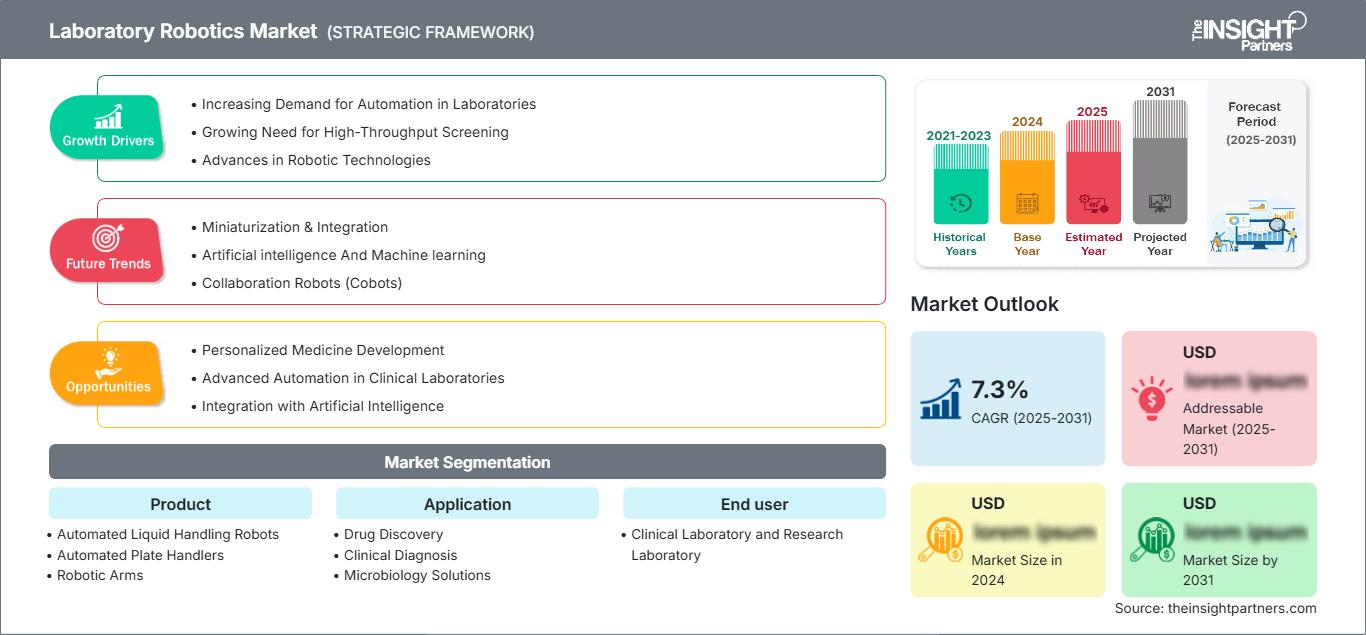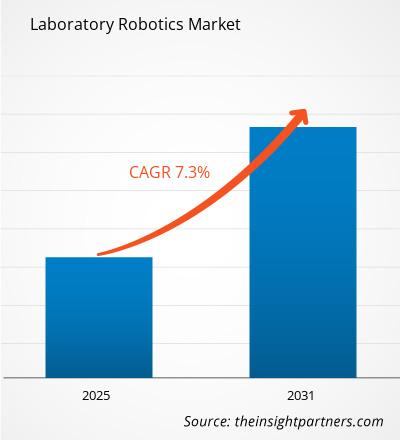Der Markt für Laborrobotik wird bis 2031 voraussichtlich ein Volumen von 5,72 Milliarden US-Dollar erreichen. Für den Zeitraum 2025–2031 wird ein jährliches Wachstum von 7,9 % erwartet.
Der Bericht ist segmentiert nach Produkt (Automatisierte Flüssigkeitshandhabungsroboter, Automatisierte Plattenhandhabungsgeräte, Roboterarme, Laborautomatisierungs-Workstations, Mikroplattenlesegeräte und -waschgeräte sowie Sonstige), Anwendung (Wirkstoffforschung, Klinische Diagnostik, Mikrobiologie-Lösungen, Genomik-Lösungen und Proteomik-Lösungen) und Endnutzer (Klinische Labore und Forschungslabore).
Zweck des Berichts
Der Bericht „Laborrobotik-Markt“ von The Insight Partners beschreibt die aktuelle Marktlage und das zukünftige Wachstum sowie die wichtigsten Triebkräfte, Herausforderungen und Chancen. Dies wird verschiedenen Akteuren im Geschäftsbereich Einblicke ermöglichen, wie beispielsweise:
- Technologieanbieter/Hersteller: Um die sich entwickelnde Marktdynamik zu verstehen und potenzielle Wachstumschancen zu erkennen, können sie fundierte strategische Entscheidungen treffen.
- Investoren: Um eine umfassende Trendanalyse hinsichtlich Marktwachstumsrate, Finanzprognosen und Chancen entlang der Wertschöpfungskette durchzuführen.
- Regulierungsbehörden: Um Richtlinien zu regulieren und Aktivitäten auf dem Markt zu überwachen, mit dem Ziel, Missbrauch zu minimieren, das Vertrauen der Anleger zu wahren und die Integrität und Stabilität des Marktes zu gewährleisten.
Marktsegmentierung für Laborrobotik Produkt
- Automatisierte Flüssigkeitshandhabungsroboter
- Automatisierte Plattenhandhabungsgeräte
- Roboterarme
- Laborautomatisierungs-Workstations
- Mikrotiterplatten-Lesegeräte und -Waschgeräte
- Sonstige
Anwendung
- Wirkstoffforschung
- Klinische Diagnostik
- Mikrobiologische Lösungen
- Genomische Lösungen
- Proteomische Lösungen
Endnutzer
- Klinische Labore und Forschungslabore
Geografie
- Nordamerika
- Europa
- Asien-Pazifik
- Süd- und Mittelamerika
- Naher Osten und Afrika
Sie erhalten kostenlos Anpassungen an jedem Bericht, einschließlich Teilen dieses Berichts oder einer Analyse auf Länderebene, eines Excel-Datenpakets sowie tolle Angebote und Rabatte für Start-ups und Universitäten.
Markt für Laborrobotik: Strategische Einblicke

- Holen Sie sich die wichtigsten Markttrends aus diesem Bericht.Dieses KOSTENLOSE Beispiel umfasst Datenanalysen, die von Markttrends bis hin zu Schätzungen und Prognosen reichen.
Wachstumstreiber des Marktes für Laborrobotik
- Steigende Nachfrage nach Laborautomatisierung: Einer der Hauptfaktoren für das Wachstum der Laborrobotikbranche ist der steigende Bedarf an Automatisierung in Laboren. Jedes Labor möchte Effizienz, Genauigkeit und Durchsatz maximieren und setzt daher bereits entsprechende Systeme für bestimmte grundlegende und sich wiederholende Arbeiten wie Probenvorbereitung und -analyse, Pipettieren usw. ein. Dies reduziert die Fehlerwahrscheinlichkeit, und es ist zu erwarten, dass mehr Investitionen in Laborrobotik fließen werden.
- Zunehmender Bedarf an Hochdurchsatz-Screening: Die Laborrobotikbranche wächst aufgrund der gestiegenen Nachfrage nach Hochdurchsatz-Screening in der Wirkstoffentwicklung. Im Rahmen der Wirkstoffentwicklung müssen Forscher in kürzerer Zeit eine größere Anzahl von Wirkstoffproben evaluieren und screenen, um die vielversprechendsten Verbindungen zu finden. Robotische Infrastrukturen ermöglichen Laboren die Entwicklung von Hochdurchsatz-Assays mit höherer Effizienz und Geschwindigkeit als bisher möglich. Dies optimiert die Prozesse des pharmazeutischen Screenings und der Diagnostikentwicklung und verkürzt die Phasen der Arzneimittelentwicklung.
- Fortschritte in der Robotik: All diese technologischen Innovationen in der Robotik heben die Position von Laborrobotersystemen auf ein neues Niveau. Künstliche Intelligenz für allgemeine Zwecke, die Integration von maschineller Intelligenz und Sensortechnologien sind einige der Vorteile von Laborrobotern. Sie führen zu hochentwickelten Automatisierungslösungen für komplexere Aufgaben, die nicht nur die Effizienz gefährdeter Betriebsprozesse steigern, sondern auch den Einsatzbereich von Laborrobotern erweitern.
Zukünftige Trends im Markt für Laborrobotik
- Miniaturisierung & Integration: Der Trend zur Miniaturisierung und Integration im Markt für Laborrobotik erfordert den Einsatz kleiner und multifunktionaler Robotersysteme. Neuere Technologien ermöglichen es Laboren, komplexe Aufgaben auf kleinerem Raum und vor allem kostengünstiger durchzuführen. Diese Roboterlösungen integrieren zahlreiche Funktionen, darunter Flüssigkeitshandhabung, Prozess- und Probenvorbereitung. Dies ermöglicht einen effizienten Arbeitsablauf, höhere Produktivität und Reproduzierbarkeit – Eigenschaften, die moderne Labore auszeichnen.
- Künstliche Intelligenz und Maschinelles Lernen: Die Kombination von KI und ML mit Laborrobotik verändert die Datenverarbeitung und Entscheidungsfindung. Solche Roboter nutzen experimentelle Daten, um KI-optimierte Roboter zu steuern. Diese können ihre Abläufe anpassen und die Effizienz von Echtzeit-Workflows steigern. Dadurch wird die Forschung und Entwicklung schneller, präziser und vorausschauender, und Laborprozesse werden effektiver und an die Bedürfnisse der Nutzer anpassbar.
- Kollaborative Roboter (Cobots): Im Laborkontext nimmt der Einsatz von Cobots, auch „kollaborative Roboter“ genannt, zu, da sie in Anwesenheit von Forschern bedient werden können. Dies entlastet die Wissenschaftler, da die meisten sich wiederholenden Aufgaben von Robotern übernommen werden und sie sich komplexeren Analysen widmen können. Aufgrund ihrer einfachen Bedienung und Anpassungsfähigkeit eignen sich Cobots für eine Vielzahl von Anwendungen und fördern so die Kreativität bei der Gestaltung von Experimenten und Projekten.
Marktchancen für Laborrobotik
- Entwicklung personalisierter Medizin: Fortschritte in der personalisierten Therapie: Die Fähigkeit der Laborrobotik, Hochdurchsatz-Screening-Verfahren zu verbessern und zu erleichtern, macht sie zu einem entscheidenden Bestandteil der personalisierten Medizin. Robotersysteme können die Wirkstoffforschung verfeinern und die Medikamentenverabreichung basierend auf dem Genom des Patienten unterstützen, was sowohl die Behandlungsergebnisse als auch die Wirtschaftlichkeit verbessert.
- Fortschrittliche Automatisierung in klinischen Laboren: Der Bedarf an schnellen, präzisen und qualitativ hochwertigen Diagnosetests hat den Einsatz von Laborrobotik in der klinischen Selbstversorgung vorangetrieben. Dies ermöglicht einen effizienten Arbeitsablauf, minimiert menschliche Eingriffe und erlaubt die Echtzeitanalyse von Diagnoseinformationen, wodurch die Bedürfnisse der Patienten schneller erfüllt werden können. Die entscheidende Veränderung in der Nutzung klinischer Labore hat zu einer Steigerung der Servicequalität geführt, was den Patienten zugutekommt, da Tests schneller durchgeführt werden.
- Integration mit Künstlicher Intelligenz: Akzeptanz von Künstlicher Intelligenz in der Laborautomatisierung: Mit der Entwicklung von Künstlicher Intelligenz sind interessante Anwendungen zur Optimierung von Forschungsaufgaben im Bereich der Laborrobotik verfügbar geworden. Robotersysteme ermöglichen die sofortige Erfassung großer Datenmengen. KI kann diese Informationen nutzen, um sowohl Fehler in den Statistiken zu erkennen als auch deren zeitliche Entwicklung zu analysieren – eine Aufgabe, die selbst für geschulte Fachkräfte oft zu komplex ist. Die Schnittstelle zwischen KI und Robotik hat den Spielraum für experimentelle Studien erweitert und die Innovationskraft in der Biotechnologie und der Entwicklung neuer Medikamente gefördert.
Markt für Laborrobotik
Die regionalen Trends und Einflussfaktoren auf den Markt für Laborrobotik im gesamten Prognosezeitraum wurden von den Analysten von The Insight Partners ausführlich erläutert. Dieser Abschnitt behandelt außerdem die Marktsegmente und die geografische Verteilung des Marktes für das Management von Herzrhythmusstörungen in Nordamerika, Europa, Asien-Pazifik, dem Nahen Osten und Afrika sowie Süd- und Mittelamerika.
Umfang des Marktberichts zu Laborrobotik
| Berichtsattribut | Einzelheiten |
|---|---|
| Marktgröße in 2024 | US$ XX Billion |
| Marktgröße nach 2031 | US$ 5.72 Billion |
| Globale CAGR (2025 - 2031) | 7.9% |
| Historische Daten | 2021-2023 |
| Prognosezeitraum | 2025-2031 |
| Abgedeckte Segmente |
By Produkt
|
| Abgedeckte Regionen und Länder | Nordamerika
|
| Marktführer und wichtige Unternehmensprofile |
|
Dichte der Akteure im Markt für Laborrobotik: Auswirkungen auf die Geschäftsdynamik
Der Markt für Laborrobotik wächst rasant, angetrieben durch die steigende Nachfrage der Endnutzer. Gründe hierfür sind unter anderem sich wandelnde Verbraucherpräferenzen, technologische Fortschritte und ein wachsendes Bewusstsein für die Vorteile des Produkts. Mit steigender Nachfrage erweitern Unternehmen ihr Angebot, entwickeln innovative Lösungen, um den Kundenbedürfnissen gerecht zu werden, und nutzen neue Trends, was das Marktwachstum weiter ankurbelt.

- Holen Sie sich die Markt für Laborrobotik Übersicht der wichtigsten Akteure
Wichtigste Verkaufsargumente
- Umfassende Abdeckung: Der Bericht bietet eine umfassende Analyse der Produkte, Dienstleistungen, Typen und Endnutzer des Marktes für Laborrobotik und vermittelt so ein ganzheitliches Bild.
- Expertenanalyse: Der Bericht basiert auf dem fundierten Wissen von Branchenexperten und Analysten.
- Aktuelle Informationen: Der Bericht gewährleistet Geschäftsrelevanz durch die Berücksichtigung aktueller Informationen und Datentrends.
- Anpassungsmöglichkeiten: Dieser Bericht kann an spezifische Kundenanforderungen angepasst werden und sich optimal in die Geschäftsstrategien integrieren.
Der Forschungsbericht zum Markt für Laborrobotik kann somit maßgeblich dazu beitragen, das Branchenszenario und die Wachstumsaussichten zu entschlüsseln und zu verstehen. Auch wenn einige berechtigte Bedenken bestehen, überwiegen die Vorteile dieses Berichts insgesamt die Nachteile.
- Historische Analyse (2 Jahre), Basisjahr, Prognose (7 Jahre) mit CAGR
- PEST- und SWOT-Analyse
- Marktgröße Wert/Volumen – Global, Regional, Land
- Branchen- und Wettbewerbslandschaft
- Excel-Datensatz
Aktuelle Berichte
Erfahrungsberichte
Grund zum Kauf
- Fundierte Entscheidungsfindung
- Marktdynamik verstehen
- Wettbewerbsanalyse
- Kundeneinblicke
- Marktprognosen
- Risikominimierung
- Strategische Planung
- Investitionsbegründung
- Identifizierung neuer Märkte
- Verbesserung von Marketingstrategien
- Steigerung der Betriebseffizienz
- Anpassung an regulatorische Trends




















 Kostenlose Probe anfordern für - Markt für Laborrobotik
Kostenlose Probe anfordern für - Markt für Laborrobotik